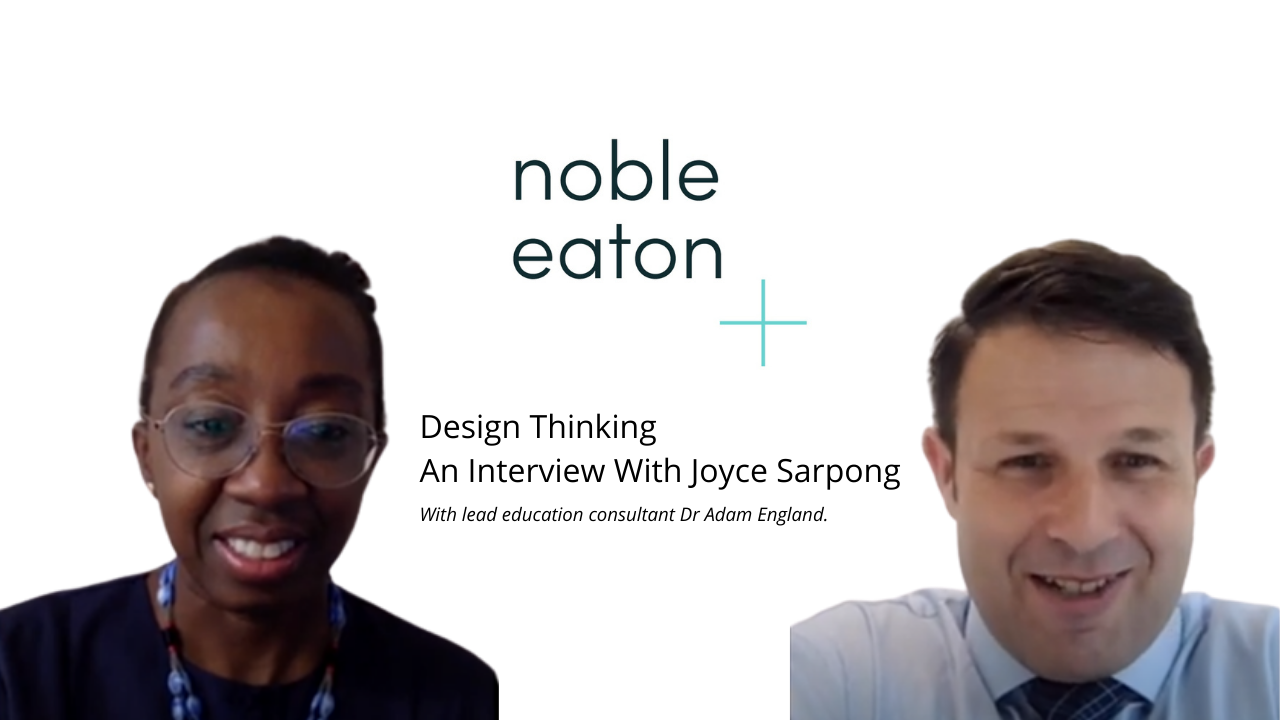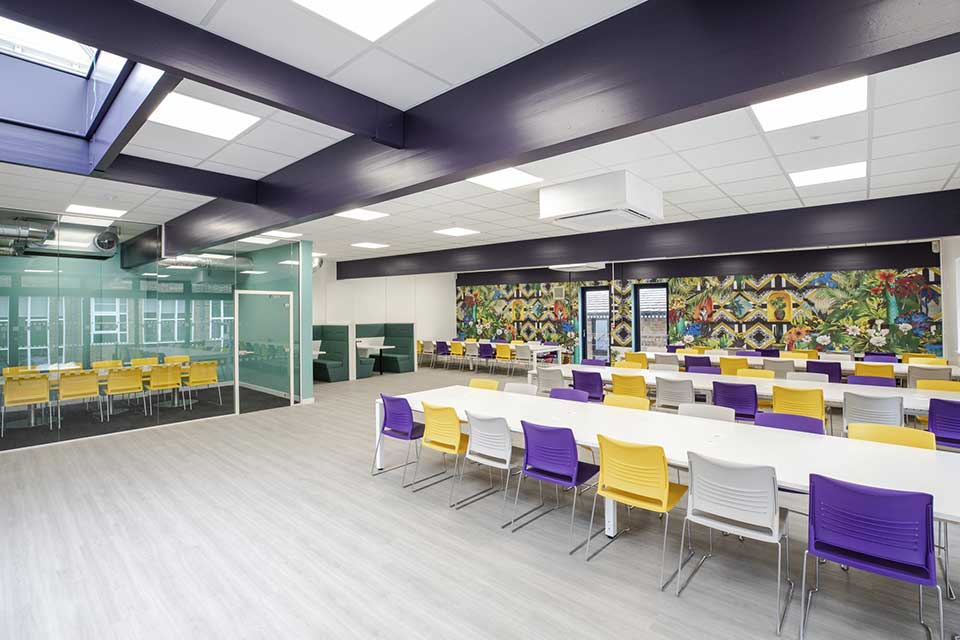Design Thinking – An Interview with Joyce Sarpong

Today our informative discussion is centred on Design Thinking. We are delighted to welcome special Guest Contributor Joyce Sarpong, Founder and CEO of AfricaOracle.
Design Thinking Background
Adam England: Design Thinking is a relatively new concept for many British schools. Could you tell us a bit more about your background and how you came to teaching Design Thinking as a subject?
Joyce Sarpong: I come from an IT background with a degree in Computing; I worked in the industry for over 25 years and did everything from coding (formerly known as programming), through to supporting and testing systems.
Whilst I love tech, I decided to move more into project management and consultancy. My work has always focused on the customer. From there I moved into the corporate industry, including ecommerce at Visa, looking at innovative solutions to banking payments. After having my children I decided to leave the world of corporate work and became a lecturer alongside roles as a school governor and member of the PTFA.
My first introduction to Design Thinking was as an entrepreneur, thinking of innovative and creative solutions to problems for customers.
Empathy Mapping
Adam England: So the concept of reverse engineering to meet a customer’s needs was obviously paramount in your thinking. When I first met you, you introduced me to a new concept, which was empathy mapping. Could you talk us through how empathy maps work with Design Thinking?
Joyce Sarpong: I see that empathy maps are the first step of Design Thinking, which is really humans creating human solutions and it’s in that sense, human-centric.
In order to think about creative and innovative solutions, we need to put the customer at the centre of everything that we are doing. Empathy mapping is about putting yourself in the customer’s shoes, thinking through what their pains and challenges are and having the ability to look at things from their perspective.
Is the UK Receptive to Design Thinking?
Adam England: You have travelled widely and have a very broad swathe of experience in business and education. What do you think the general response is to Design Thinking in the UK? Are we receptive to the concept or is it not something we generally buy into as a nation?
Joyce Sarpong: That’s a very interesting question. In terms of how receptive the UK is I would say it’s very much early days.
Design Thinking as a process started off at Stanford University in the US – thinking about the UK, I see it in areas where medication or innovation is needed but the people who would be thinking about using it I would say have more of an academic bent.
I feel the reason for the hesitancy or lack of mass adoption for the approach is down to society. As a society, the UK has a stronger individualistic than collective approach, so everything is based around personal or organisational success.
Whereas empathy is asking you to think about others, which is a collective mindset.
Adam England: When we first met, we talked about working in Africa. I spent over three years in Africa and I found that my African colleagues’ capacity to generate Design Thinking solution was far greater generally than the education sector here.
Do you think the educational sector here is particularly receptive to Design Thinking and if not, why not?
Joyce Sarpong: In some of the recent conversations I have had, broadly speaking I would say perhaps not as receptive in the UK.
Education in the UK has some traditional aspects to it for example, ‘this is how we have always done things’; ‘this is the way we do things around here’. There is that mindset of being embedded in the tradition of how schools are; but those that do take on the concept of Design Thinking are more forward thinking and look to the future by thinking about the students they want to bring into society.
There needs to be a shift from only looking at results and the success in terms of academic outcomes for children – yes, these are important – but increasingly, as the pandemic has shown us, we need to consider other factors such as how we nurture and cultivate leaders.
Who is likely to adopt Design Thinking?
Adam England: It seems that 10-15% of schools in the UK are more than willing to work with the concept of Design Thinking. I don’t know if you’ve had interactions with any of them but if you were hypothesising, what sort of schools do you think are more likely to adopt a Design Thinking approach with regards to providing for their students? Joyce Sarpong: Most schools would need to do some strategic planning. As time goes on there will be some thinking around what can be done differently. There has been a lot of changes, a shift in the way we would normally do things in an educational setting. So in terms of which type of schools, it is those that are willing to embrace new ways of working and doing things – those that are not just looking at their own micro-environment but looking at the macro environment and how things are changing, and what opportunities are out there for them to make these changes. Design Thinking would definitely be one approach that could be used to bring about those changes.
What does your perfect school look like?
Adam England: Post pandemic gives us an opportunity to reset to a degree, with schools able to look at the character and the wellbeing they want to generate from their provision. With that in mind, as a design thinker, if you were to design the perfect school for your children in the upcoming decades from 2030 and 2040, what would be first on the agenda (not just for standards but for wellbeing, character and more)? Joyce Sarpong: If I were to design a new school, just like with Design Thinking the first thing to get right is the people in the school, starting with the Senior Leadership Team and working from there. I would be looking for people with an open mindset who want to embrace change and who are adaptable. This thinking must be embedded right throughout all staff in the school. In terms of what that would look like, it would be an environment that is conducive for creativity and narration and the various different ways that could be brought about or incorporated into an academic setting. To make sure students are the citizens we want to see in the world when they leave school, we need to look at how they are nurtured through their time in education and how we can continue that relationship with them for as long as possible when they leave school. Children are still growing up to the age of around 25, so there is an opportunity there for schools to be creative with how they engage with their alumni, especially for the first few years of their careers. It’s about putting the child at the centre of their schools, which most look to do. Adam England: That begs the question – if many schools do put the child at the centre of their thinking, why therefore do many schools not create more inclusive learning environments which speak to the neuro divergent as well as the neurotypical and the question I would ask is: Is that an issue of mindset, or politicisation of education or is it simply an issue of funding? Joyce Sarpong: I do not think it’s an issue of funding. I think it’s a mindset of mindset and politicising. Schools have the capacity – if you look at children by the time they get to the age of 7, you have an idea as to the learning style and needs of the child. However, often in a school setting the school will not be engaging with the parents to alert them as to what needs to be done. If a school doesn’t have the capacity to handle children with different learning styles, then it’s the responsibility of the school to inform the parents so they can have a discussion around what is the best outcome for the child. I don’t think that is done enough. Those schools that do have the capacity have to find ways they can accommodate all types of children, because real value in the school is shown by those who are able to take in a diverse range of students and get them to fulfil their full potential. Adam England: It seems the change agenda has to come from the top down, from the leadership team that are open to creating a more inclusive environment and then that has to cascade to the staff to work more closely with the parents to support children in creating a more bespoke type of arrangement to cater for a variety of different learning styles and personalities.In so doing, you make a school sound like a ‘school for life’ which is what it should be, isn’t it?Joyce Sarpong: Learning is for life; if you have been to a great school you will want to have that affiliation with the school for life.
Your Top 3 Tips
Adam England: So to sum up, what are your top three tips for educational leaders in the UK when it comes to Design Thinking in schools? Joyce Sarpong: Firstly, embrace Design Thinking because it aligns with educational objectives by putting the child at the centre of everything. Secondly, leadership – there needs to be buy in from the top. How will schools embed these strategies? Design Thinking is one of the main approaches that could be adopted to embed their strategic objectives into their school’s plans. Finally, it’s easy to do things in-house; sometimes having external facilitators can help bring new perspectives.
Who has embodied those top tips?
Adam England: That sounds like a set of guidelines to success! I know you are widely travelled – is there a country or society that has really embodied the essence of those top three tips? Joyce Sarpong: Thinking about countries that embodies that in terms of education, Finland comes to mind. There are other countries on the African continent that would embrace it but that may not be currently aware of these kinds of approaches and how they could adopt them within their schools. Adam England: Africa is the ‘hidden jewel’ of this way of thinking. I found my colleagues in Lagos were far less bound by legacy thinking and therefore far readier to adopt that Design Thinking mindset. As much as Scandinavian countries are seen as leaders in this field, emerging and developing countries also show a willingness to move forward and embrace technology and new thinking that should not be disregarded. Joyce Sarpong: Absolutely – Rwanda, Botswana and West African countries like Ghana and Nigeria are forward thinking and this is particularly evident at the tertiary level, if not at secondary also. Many private universities are very innovative and creative in what they are delivering. Adam England: That innovation and creativity are central to the entrepreneurship cultures that you see readily growing out of Africa and Rwanda is a very good example – at the beginning of the pandemic, way ahead of what was happening in Europe, Rwanda already had temperature checks and testing controls at its airport whereas at Heathrow you could just walk through. Joyce Sarpong: I heard on the radio that a British journalist in Ghana had a very similar experience and was astounded that Ghana were using drones to deliver vaccines. Kenya is also known for its innovation and creativity. We need to find those countries that are receptive to this new way of thinking. Adam England: Accountability, Empathy, Creativity – gives us the acronym ACE which is perfect for what we have been talking about!
Don’t forget – we really want to hear about your experiences with the various iterations of Design Thinking you have used. It’s only by sharing and talking about these experiences and explorations that we will find the optimal combinations to support the broadest range of learners possible.
So please, join our Design Thinkers’ group, share your experiences, talk to us about the iterative facets of what it is you have done and above all else, please remember that by doing that, that is how we will incorporate Design Thinking as an embodiment of successful thinking in schools across the UK and beyond.




